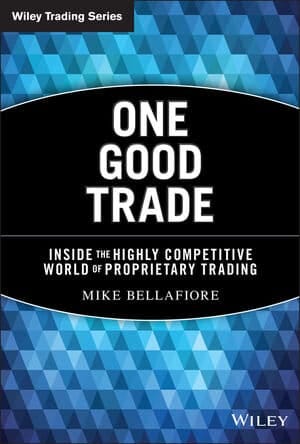Dr. Steenbarger: Solution-Focused Positive Trading Psychology
Dr. Steenbarger explains a new approach to looking at Trading Psychology!
We continue the TraderLion Conference 2024 series with Dr. Steenbarger where he breaks down a different, more positive approach to trader psychology!
About Dr.Steenbarger
Dr. Brett Steenbarger is a renowned trading coach, psychologist, and author of several influential books, including “The Psychology of Trading” (2003), “Enhancing Trader Performance” (2006), and much more.
As a performance coach for portfolio managers and traders at financial organizations, Dr. Steenbarger focuses on enhancing trader performance by drawing on research from expert performers in various fields. His insights have revolutionized the approach to trading psychology, empowering traders to achieve consistent success. Respected worldwide, Dr. Steenbarger continues to inspire and mentor traders, significantly contributing to their growth and success.
Solution-focused Positive Psychology
You want to focus on investigating when you are trading at your best and reverse engineer what works. Do more of what works!
For example, if you are married and the marriage hasn’t been working due to problems in the relationship. A solution-focused approach would be to figure out the best aspects of the relationship, why you married this person in the first place, and work backward to find a solution.
So instead of looking at why a trader is tilting or missing trades, a better approach could be to look at the times when you traded very well. You entered and exited the trade perfectly, how did you do that? What were you thinking? What were you doing? And after we look at success after success, we can piece together our best practices. What personally works as a trader and then build on that concept.
The focus on solution-focused trading psychology is the encouragement to do more of what works and cultivate your strengths for better performance.
Developing a Vision
Define a business plan and future goals for trading success
As a trader, you are essentially an entrepreneur. An entrepreneur not only needs goals but a vision to get better over time to inspire their efforts.
Take on a leadership role in organizing and leading your life effectively
In one’s own life, there are many key components; relationships, personal activities, trading, outside careers, etc. From that vantage point, our life is an “organization”, and we are the leader of that organization. Most people live on autopilot without goals or aspirations.
Knowing your Strengths
Over-utilizing strengths can lead to weaknesses and imbalance
For example, a strength one may have could be leadership. But in wanting to lead people you forget to listen to them and as a result, your strength in leading people becomes a weakness associated with trying to control others
Growth often comes from using latent strengths when facing challenges, while benefiting from the strengths of others enhances performance
The Sine Wave Exercise
An exercise Dr. Steenbarger likes to do with people is, first draw a sine wave. The peaks of the sinewaves are the peak experiences of your life, the most meaningful and positive experiences. The troughs are the worst experiences of your life, the most painful and difficult. You then look across the peaks and troughs and try to identify the themes. And you will notice what your strengths are and what really drives/ motivates you.
Trading Process as Expression of Our Strengths
For example, Dr. Steenbarger trades the Stock Index Futures. He looks at high-frequency data about the buying and selling in those future contracts. One of the things he looks at is every transaction in the ES contracts and is that transaction occurring at the bid or the offer price? Therefore are sellers dominating or buyers dominating? He is aggregating that data, and can then see sentiment shifts over time within the data. This is making use of the strength that Dr. Steenbarger has as a psychologist because as a psychologist it is a matter of listening, analyzing, and understanding people and their problems. He is listening to the market in the exact same way.
Look at your trading process and can you link that to your personal strengths
The PERMA+ Model
The PERMA+ model is a theory of well-being by Dr. Seligman. There are five building blocks that enable flourishing:
P - Positive Emotion
E - Engagement
R - Relationships
M - Meaning
A - Accomplishments
+ - Physical Well-Being/Health
People will derive well-being from each of these five building blocks to varying degrees. This applies to trading because…
Our state of well-being determines what we process!
Every one of the building blocks will affect your trading process consciously or subconsciously and it is your job to improve those blocks over time.
Trading Shapes Our Psychology
There are people who say we can solve our trading problems by trying to solve our trading psychology. They try to use psychology to improve their trading when in fact, trading better helps our psychology
You want to look at every facet of your trading process and ask yourself, how is this part of your trading, making use of your strengths? By doing this, it will make us feel intrinsically rewarded and fulfilled.
Let’s take the trading process and break it down:
Generating Ideas: Discovery
How does it make use of our strengths?
Translating Ideas Into Trades: Market Feel
How do we obtain the market feel that tells us to proceed with a trade?
Sizing Positions: Our Risk Personality
All of us have different levels of risk. How do we size a position to where they are meaningful but they fit with our risk personality.
Updating Risk/Reward: Flexibility
As the position evolves and the market moves, our Risk/Reward changes. You need the flexibility to update and manage the position in real time.
Diversification: Balancing Risks/Rewards
If you are an active intraday trader, diversification will be different than a hedge fund portfolio manager. The short-term trader diversifies by trading more than one ticker but also by trading long, short, and different timeframes. While a hedge fund manager will diversify by having a basket of uncorrelated assets.
Something that I talked about in another post is this exact concept! I think for me personally as a trader, because I trade swing breakout setups my win rate is significantly lower than 50% but my Risk/Reward is significantly higher. The one consequence of this is that at times I feel demotivated by taking multiple consecutive losses and it becomes a vicious cycle of trading, losing, getting demotivated, and ultimately falling out of my routine. I am leaning now toward higher win-rate strategies because of this. But this is just me and for others, the homerun style trading may fit your personality. Your trading process must match your personality and strengths!
Doing what you do, well, is helping you have more energy, more focus, and more motivation.
Is Your Trading Making You a Better Person?
If we truly focus on building our strengths, it should make us better as people and this is very different from trading with the ego
“To love money is to know and love the fact that money is the creation of the best power within you, and your passkey to trade your effort for the effort of the best among men.” - Ayn Rand
When we are making money the right way, we are tapping into the best power within us and the best powers of other people.
Questions and Answers for Dr. Steenbarger
Exercises that traders can do to find their strengths and weaknesses with regards to post-trade analysis?
Just like if you were analyzing a losing trade and pinpointing what you did wrong and how you would correct that. You want to study your winning and best trades and you are pinpointing what you did well.
I entered at this point… What told me this was a pivotal moment in the market?
I sized up on this setup… Why did I size up? How did I choose that size?
If you do that day after day, common strengths will appear. Those are your “best practices”. Once you generate those best practices, you can create a checklist and it then becomes a guideline to ensure that you are tapping into your strengths.
How could a trader emphasize the positive feedback loop mentioned in the presentation? If a trader isn’t doing so hot in the week how can they get back on track?
Dr. Steenbarger mentions “One Good Trade: Inside the Highly Competitive World of Proprietary Trading” by Mike Bellafiore and that the idea of having that one good trade should be the focus if you haven’t been making money. Sometimes, a trader will be trading very well but the facets of the market change (ie. volatility adjusts, sectors rotate, etc) and they just haven’t made the adjustment. But then the focus becomes, let’s take the next trade and do it well! Put on “One Good Trade” and get our rhythm back.
Life diversification: If trading is your whole life, and I go into a trading slump, then I will feel devasted because that would be your entire life. If you are invested in different aspects of your life (community activity, family, relationships) and you enter a trading slump, it will be less impactful to your psychology than if trading is your entire life.
It really helps if you have one or more things in your life that are more imporantnt to you than trading and PnL.
For retail traders who may have a hard time finding like-minded traders, what advice can you give them to seek out and expand their network? How important is your network to becoming a better trader?
It is incredibly important for a retail trader to find a group of traders that you can bounce ideas off of. One of the great values of a community is the diversification of ideas and the ability to share best practices that you may not have known.
For a new beginner trader, where do you think they should double down and focus on building their trading system vs building their trading psychology system?
It should be an integration. Remember, developing one’s trading is ultimately a way to develop one’s self (if done right). For Dr. Steenbarger, in his own trading, a big leap in progress was when he stopped using timed-based bars (ie. 1 bar = 1 minute) but instead looked at volume-based bars (ie. 1 bar = 5000 contracts traded). He was able to get perspectives that were not possible with time-based bars and he was able to get a much better feel of the market. This is an example of how that leap improved his trading and that improved his feel for the market/ trading psychology.
Resources that you would recommend when getting started with trading psychology?
There are a number of great trader psychology books. His notion of a book is that if you could just take away one idea that makes a positive difference in your trading and you spent $20-40 on the book, that is a pretty good investment. On Brett’s blog, you can find a list of books.
Index of TraderLion Trading Conference 2024:
Day 1:
Marios Stamatoudis: The Two Layers for Building Trading Mastery
Dr. Steenbarger: Turning Personal Strengths into Trading Strengths
Pradeep Bonde: Swing Trading Catalysts and Momentum Bursts
John Burns: How to Tap into Your Intuition – Turning Your Mental Game into a Trading Edge
Roy & Wes Mattox: Tracking Market Trends and Market Environments
John Pocorobba: Building Confidence Trading Earnings Gaps







